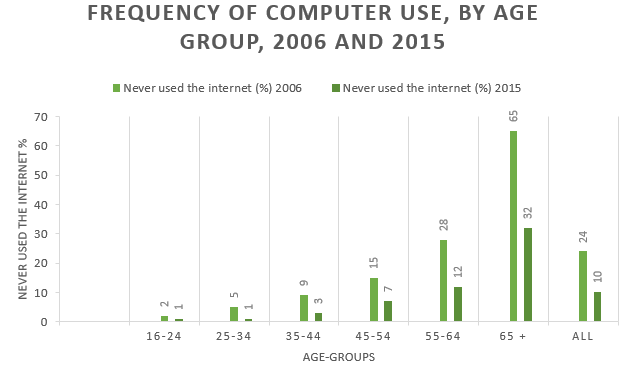
Despite the ubiquitous presence of the internet in our daily lives, the 2013 BBC Media Literacy study showed that some 21% of people can’t use the web and 14% didn’t have any internet access. This means that 7% of the population can access the web, but do not feel that they have the necessary skills to make the most of it. All of these people are classified as being digitally excluded.

Source: ONS, Internet Access – Households and Individuals (2015)
The world is increasingly moving online first – whether it be for online shopping, banking, or social media. As such, those final few digitally excluded individuals will need to be equipped with 'the skills, motivation and trust to go online [and] be digitally capable', according to former Cabinet Office Minister Francis Maude. Digital inclusion is all about reducing digital exclusion; making sure that people have the capability to use the internet to do things that benefit them day to day.
Access and availability: Extending superfast coverage
Making superfast broadband available to everyone is just a first step in tackling the digital divide.
For this, the government is spending upwards of £1 billion in improving broadband and mobile infrastructure so that by the end of 2017, the government and BT Openreach plan to have made available superfast broadband to 95% of all premises in the UK. The map below shows average download speeds by parliamentary constituency in 2014. Many of the slower speeds are found in remote and rural areas (the final 5% of hardest to reach areas), but there are also issues in urban areas.
The government is also exploring options for getting near universal superfast broadband coverage across the UK by 2018, such as raising the Universal Service Obligation (the legal entitlement to a basic service) to speeds no slower than 5Mbps, up from just 24kbps.
As ever-increasing broadband speeds become available, the problem of ‘digital exclusion’ is only going to be exacerbated for those communities who have little chance of accessing the services.

Fixed Broadband Speed by Parliamentary Constituency GB, 2014. House of Commons Library analysis of Ofcom’s Infrastructure report, 2014.
Too old, unskilled and poor: Barriers to digital inclusion
Age, gender and socio-economic status are all factors that contribute to digital exclusion. The table below shows that in 2015 just 1% of 16-24 year olds had never used the internet, compared with 32% of those aged 65 and older. That said, in 2006, 65% of the over 65s had never used the internet (more than the double the number in 2015).

Source: ONS, Internet Access – Households and Individuals (2015)
Digital exclusion and social exclusion are interrelated, and appear to be reinforcing. For instance, in 2010, the ONS surveyed the UK population to find that:
- 55% of those with no formal qualifications had never used the internet compared with 2% of those with a degree.
- 33% of those in semi-routine and routine occupations had never used the internet vis-à-vis 9% in managerial and professional occupations.
- 17% of those with an annual income of less than £20,700 had never used the internet compared with 2% of those with an annual income greater than £41,600.
A report by Price Waterhouse Coopers examining the economic case for digital inclusion reinforces these findings on social and digital exclusion:
'Social disadvantage in the form of poorer qualifications and lower skills can lead to individuals being either unable or unwilling to use digital technologies. It could also be the case that an inability to become fully digitally engaged leads to social exclusion, especially in the forms of reduced employment and socio-political networking opportunities'
The profile of those people most excluded is an important consideration for the government as it seeks to make its services ‘digital by default’.
Digital Skills: Are you a ‘digital muggle’ or a ‘digital maker’?
The journalist and broadcaster Maggie Philbin was commissioned by Ed Miliband towards the end of 2013 to report on the Digital Skills needs of the UK. This taskforce engaged with hundreds of organisations to look at what needs to be done to nurture home-grown talent to meet the needs of Britain’s modern economy. As part of the review, the taskforce defined four broad groups of digital skills in the UK workforce:
- Digital Muggle: 2.2 million people (7% of the workforce). No digital skills – digital technology may as well be magic.
- Digital Citizen: 10.8 million people (37% of the workforce). The ability to use digital technology purposefully and confidently to communicate, find information and purchase goods/services.
- Digital Worker: 13.6 million people (46% of the workforce). The ability to evaluate, configure, and use complex digital systems. Elementary programming skills such as scripting are often required for these tasks.
- Digital Maker: 2.9 million people (10% of the workforce). Skills to actually build digital technology (typically software development). The Digital Maker category is interpreted quite broadly to include, at the low end, for example, workers who regularly create complex Excel macros or data files for controlling 3D printers.
The House of Lords Digital Skills Committee concluded in February 2015 that almost everyone in the workforce will soon need, as a minimum, the skills identified in the 'Digital Citizen' band to do their role.
Digital inclusion strategy
To reduce digital exclusion, the coalition government published the UK Digital Inclusion Strategy. Digital inclusion is all about making sure that people have the capability to use the internet to do things that benefit them day to day.
In announcing this policy, the Cabinet Office minister Francis Maude, stated that the strategy is aimed at ensuring people have the capability to use the internet in a beneficial way – whether they are individuals, small and medium enterprises or voluntary community and social enterprises. The government believes that empowering people to go online can help tackle wider social issues, support economic growth and close equality gaps.
The government is working with the digital skills charity Go ON UK and UK Digital Inclusion Charter signatories to achieve the aims set out in the Digital Inclusion Strategy. To do this, the government has outlined ten actions it, and its partners, will need to deliver. If the government succeeds, the number of people who are offline will have been reduced by 25% by 2016 (and a further 25% every 2 years after), and by 2020, everyone who can be digitally capable will be, according to Francis Maude.
This article first appeared on the the House of Commons Library blog.



